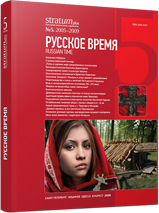Об одном типе погребальных головных уборов у южных северян в конце X – XI вв.
On a Type of Funeral Head-Dresses of the Southern Severyane in Late 10th-11th Centuries
Author(s): Andrei G. ShpilevSubject(s): History, Archaeology, Visual Arts, Middle Ages, 6th to 12th Centuries
Published by: Издательский дом Stratum, Университет «Высшая антропологическая школа»
Keywords: Funeral Head-Dresses; Southern Severyane; Zhideevka treasure
Summary/Abstract: This article is devoted to the questions about the time of existence, evolution and constructive peculiarities of a headdress with lamellate ochelie, found in the funeral complexes in the southern Left-bank Dnieper districts and dated by the late 10th-11th centuries.The lower existence date of ochelie is dated by the materials of Zhideevka treasure (Kursk region, Russia). Its cover is attributed to the second part of 980s and is connected with the events that led to the final inclusion of the northern territory in Kievan Rus’. As a result of the peculiar Vladimir buffer zone formation along the Seim River, the united Severiane population was broken into 2 parts, each with its own complex of ethnic defining decorations. Thus, the districts situated to the South from the Seim River are characterized by spiral rings and non-ornamental lamellate silver ochelie with hook-shaped endings. They are typical for a funeral women’s head¬dress of female representatives of Severiane groups, which inhabited the upper reaches of the Sula, Psiol and Vorskla rivers in early 9th century.The analysis of Gochevo barrow necropolis funeral complexes (Kursk region, Russia) has identified a group of female burials united by the presence in their inventory of lamellate ochelies. Presence of ochelies in the burials of women who were the representatives of Severiane of the Upper Desna River, Radimichi and possibly Viatichi, suggests migrants from these territory who were included into the tribe structure of the local Severiane, recognition of their status in the native land and the subsequent full cultural assimilation.Identification of some temporary groups inside the funeral complexes with ochelies allows a reliable dating of their existence within several decades and determining the upper date of ochelies by the second quarter of the 9th century, during which they firstly co-exist and then are displaced by a head venchick, which survived during the whole second part of the 11th century.The article is an attempt to reconstruct the headdress and decoration complexes of the southern Severiane at the stages of their development observed in late 10th-11th centuries. The article contains pictures of things, plans and photographs of burials and graphic reconstructions.
Journal: Stratum plus. Археология и культурная антропология
- Issue Year: 2009
- Issue No: 5
- Page Range: 338-351
- Page Count: 14
- Language: Russian
- Content File-PDF

